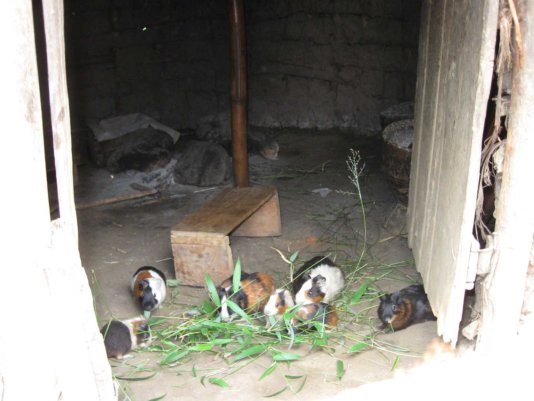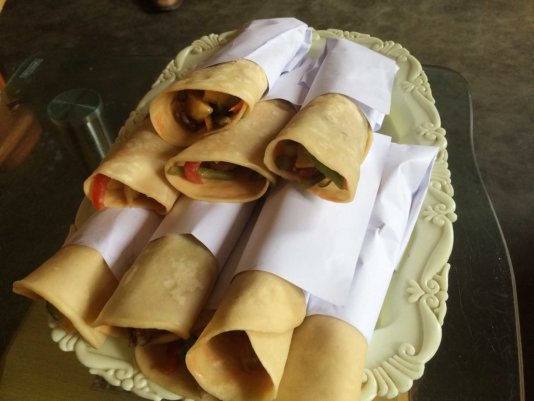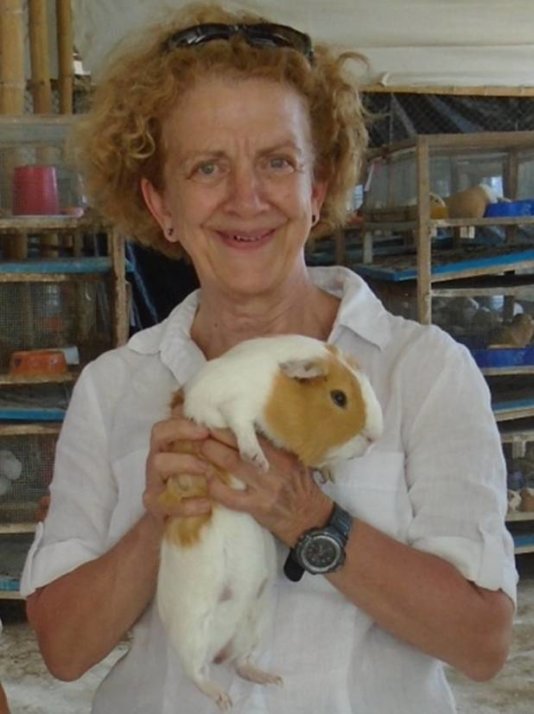- About
- Topics
- Story
- In-Depth
- Picks
- Opinion
- News
- Donate
- Signup for our newsletterOur Editors' Best Picks.Send
Read, Debate: Engage.
| August 14, 2019 | |
|---|---|
| topic: | Food Security |
| tags: | #Latin America, #malnutrition, #cavies, #Africa |
| located: | Colombia, Nicaragua, Guinea, Peru |
| by: | Frank Odenthal |
FairPlanet: Brigitte Maass, you have taught 'agrobiodiversity in the tropics' for ten years at the University of Göttingen, Germany. And you have lived in South America and Africa for 21 years and have decades of experience in international agricultural research for development. What is so special about guinea pigs that you are committed to supporting their breeding and spreading in Africa as well?
Brigitte Maass: Before we’re getting started, let me first tell you that in English we really tried very hard not to call the animals 'guinea pig', but 'cavies' or 'domestic cavy' instead, because they are neither pigs nor do they come from Guinea. It would be a 'framing', which hopefully allows us to overcome the image of the lab or pet animal.
A Peruvian anthropologist, Edmundo Morales, who published an interesting book in English, refused to use the word 'guinea pig' in English. He just wrote "cuy", as the animal is called in Peru.
I even found an article written in Swaheli, which says "Kavi kwa njama", meaning 'Cavy for meat'. In fact, every kind of test object is called "guinea pig" in English, and that is very inaccurate.
Originally cavies come from South America…
That’s right. They occurred in South America long before the first European conquerors arrived. In fact, there are indications that they were kept and bred by indigenous peoples thousands of years ago as a source of meat.
Their scientific name is Cavia porcellus. They are not pigs, but belong to the rodents, with rabbits being the closest other farm animals. In South America you find them wild in the grasslands of plains as well as in the mountainous regions of the Andes, but not in the rain forest of the Amazon.
And in South America they are a popular source of meat?
The people of South America call them ‘Cuyes’ or ‘Cuy’ and, especially in Peru and Ecuador, they have become indispensable as food. You can actually find them on the menus of fine gourmet restaurants in Lima. They are part of the culture in these countries and are even being exported at small scale to the USA and southern European countries, where large numbers of South American migrant workers live. In some places, they are even believed to have healing effects; Cuy soups, it is said, are supposed to be a remedy against cancer, but there is no medical proof of that.
But is it a healthy meat?
Yes, it is. Their white meat is rich in protein, similar to that of chicken, but contains many polyunsaturated fatty acids, which have beneficial effects on health, especially on the cardiovascular system. With regard to Africa, where people in many regions suffer from malnutrition and food security is still a concern, this could be very promising.
Some agricultural researchers say there is no need to introduce a new species from another continent. In Africa, they say, there are enough rodents that are suitable for consumption, such as the grass cutter. They point to the many problems that invasive species can cause.
Cavies have never been and will probably never be an invasive species. They are too shy to escape from the houses or kitchens. If you go into an African or South American farmhouse, you will not see any cavies. They only come out of their hiding places after a while and then scurry around on the ground. You have to be careful not to step on them — a common cause of death. In fact, it is a great advantage that cavies have over rabbits, which must be kept in cages; otherwise they would escape and could become feral. There is not a single evidence-based report on cavies as an invasive species worldwide. That concern is always coming from people who are unaware of how far cavies are already spread in Africa.
So, cavies are already spread in Africa?
Oh yes. They have been there for a long, long time. Who introduced them first in Africa, is still not clear though. It could have been European missionaries who brought them to the continent.
It is now exactly ten years ago that we first discovered cavies in eastern Congo. Of course, it was only a discovery for us Europeans; Africans have known for a long time that they can produce, eat, and sell cavies.
How many cavies are in Africa?
It is very difficult to estimate the size of the cavy populations because it changes continuously. Assuming there are at least 2 million animals in the Congo and more than half a million each in Tanzania and Cameroon, we are likely to have a total of around 5 million in a broad belt of sub-Saharan Africa. And that's quite a substantial figure for an animal that most people think does not exist at all in Africa.
To give you an idea: According to the latest estimates from the Andean countries, there are around 22 million cavies in Peru alone, 15 million in Ecuador, 6 million in Bolivia and 3 million in Colombia. In fact, in Peru, people now start to estimate only the number of mothers because the stocks vary too much to allow for meaningful statements.
Cavies are not mentioned in the official statistics and livestock censuses of most African countries. Why is that?
I assume that these official agricultural surveys were originally conceived by Europeans. And in Europe, cavies are not seen as food and, therefore, they did not appear on the census animal lists. In addition, the enumerators usually do not enter the houses. But that’s where cavies are kept.
By the way, it’s actually not true that Europeans don’t eat cavies. In Italy, for instance, they were promoted until the 1960s. In Piemont, the animals used to run around freely in the cowshed, and they fed on the feed left over by the cows, as an Italian woman once told me.
What is the difference between keeping and raising cavies in South America and Africa?
Originally, the systems of raising cavies were very similar because in both continents, the animals are traditionally kept free-running in the house or the kitchen. A family holds about 15-20 animals of all ages and sexes. Feeding also takes place on the floor. The animals feed on all kitchen wastes, crop residues and are also given all sorts of herbs and grass. Typically, they are raised by women, youth and children.
Especially in Peru, the improvement of cavy breeding started around 50 years ago, beginning with the separation of age groups and their feeding according to needs, better sanitary conditions and, finally, with the selection of faster growing animals that attain higher weights. Nowadays, commercially produced animals usually reach 800-1000g slaughter weight in only 2.5-3 months. In comparison, African cavies have usually reached only about 400-500g when they are eaten.
The meat content of the improved races is much higher than of the traditionally produced. Part of the commercial production takes place in large farms that hold 20,000 or more animals. However, 70% of cavies in Peru are still produced by smallholders under semi-commercial conditions, e.g. with 30-1500 mothers in the Peruvian Mantaro Valley. Meanwhile, the farmers have joined forces in marketing associations, so that there is continuous supply in the market.
There is no such thing in Africa. The only major cavy producer known to me is Thierry Metre in South Kivu, who keeps 400 and more animals according to the Peruvian production model: for every 10 females, there is one male kept in open wooden boxes, about 1 x 1 m large, with straw bedding and feeding of improved planted grasses and legumes.
Apart from the healthy meat, are there any other advantages of raising cavies?
Basically, as I said before, cavies are easy to keep and investments are low; usually a small cage is enough, or you just let them run around freely in the kitchen or in another room. And they are shy animals, so they do not use every opportunity to escape, like rabbits would do.
Cavies are – unlike chickens – no food competitors to humans because they are strict herbivores and can digest a number of plants that are completely unsuitable for us. A bit like ruminants (for example cows), but they only have one stomach, however an incredibly efficient digestion. Many peasants reported that they also greatly value the manure produced by cavies as a fertiliser, for instance for their vegetable garden.
In some forest areas in the Congo or in Cameroon, cavies are also promoted as an alternative to 'bushmeat' to protect the natural diversity of native animals.
You can see they appear to have multiple roles to play and accumulate so many advantages.
And why should cavy breeding be extended and improved, especially in Africa?
Since cavies are often held by women, youth and children, they seem to be a good means to support and empower these more vulnerable groups. In particular, we learned in eastern Congo that women actually own cavies, while they are not the owners of other animals. This means they can slaughter and prepare them whenever they want, without having to ask for permission. Of course that helps a better family diet. In addition, there is only a very small chance that their meat spoils uncooled under tropical conditions because, due to its small size, usually the entire animal is consumed immediately.
When women sell the animals, the money is either used for family needs or to pay school fees for the children. We met many young people in Cameroon and eastern Congo or heard about young men in Ivory Coast, who produce cavies to finance their secondary education or to earn an income.
They have already turned out to be an asset in Africa’s many conflict regions; see for instance the 1990s in eastern Congo and adjacent areas, during which hundreds of thousands of refugees had to be cared for. You can easily grab two cavies and put them into your pocket if you have to run away. That does not work with cows, goats or pigs. They are looted again and again by armed gangs. So sadly, a cavy is also a farm animal that thrives under such conflict conditions. Together with horticultural seeds, non-governmental organizations keep distributing them in large numbers as so-called ‘starter kits’ among refugees in North Kivu, eastern Congo as a first step out of poverty – up the so-called ‘livestock ladder’.
What are the difficulties in promoting the use of cavies in Africa?
By the year 2000, there was almost no research or extension available on cavy production in Africa. The animal – and its owners – were completely ignored. This means that the knowledge and know-how accumulated in South America over the past 50 years is hardly known in Africa – also because of language barriers. Worse, however, is the complete worldwide ignorance of the sheer existence of these animals in sub-Saharan Africa. This also leads potential donors to refuse to finance projects because they don’t want to introduce new livestock to Africa. They usually ask: "Why don’t you work with African bush rats"? But those would have to be domesticated first. This has been done with cavies over 5000 years ago. They are, therefore, tame and very easy to keep.
And most importantly, they are already there! And their keepers are often among the poorest and in desperate need of support.
However, there are also areas and populations in some African countries who regard cavy as a rat and, therefore, reject it. But we do not force anyone to produce or eat cavies. I also do not think that cavies should necessarily be introduced everywhere, although of course they are a real alternative with their delicate and healthy meat based on plants.
You have great experience in cavy projects and studies in both South America and Africa. Can you tell us something about it?
As a young agricultural scientist, I lived in Peru and Colombia in the 1980s and 1990s, but then I had nothing to do with cavies. I knew they would be eaten there. At that time, that seemed as exotic to me as to all the other foreigners. Of course I tried them. But I only participated in actual projects since 2009. That year, I started a new research assignment for the International Centre for Tropical Agriculture (CIAT) in eastern Africa. In 2009, we had just launched a collaborative project with participants from Colombia, Nicaragua and the eastern DR Congo. The project aimed to promote tropical forages for animals with only one stomach, such as chickens, pigs, rabbits or cavies. However, we had excluded the latter because we all thought: from the project countries, they only exist in Colombia, and even there they don’t play a major role nationwide. In June 2009, when we surveyed farmers in South Kivu on animal husbandry and animal populations, every second respondent had cavies at home. That was a big surprise for me because I had never heard of them in Africa and that they were eaten there. I searched the internet to find out more, but there was very little information on the subject. I also contacted some experts in South America to find out more about cavy production and marketing.
In 2011, we launched a research-for-development project in Cameroon and Eastern Congo dedicated solely to cavies, where we aimed at developing the value chain. The International Livestock Research Institute (ILRI), headquartered in Nairobi, Kenya, also hosted a junior scientist from Ivory Coast who researched the diversity of cavies there and, in 2011, I supervised a young German student who carried out studies in the southern highlands of Tanzania to understand the importance of cavy husbandry there. In Tanzania, I found it particularly sad how many HIV/ AIDS orphans had a cavy husbandry to make a living. The children and their old grandparents were not able to manage larger animals.
At that time you decided to stimulate South-South cooperation between South America and Africa?
After the emergence of the idea that South American researchers and experts could “piggyback” their knowledge to African colleagues so that they need less time to achieve good results, we held an international workshop in Cameroon in 2016. Likewise, in 2016, I visited quite extensively different areas of Peru. There, I made further contact with researchers and producers to learn more and pass the knowledge on to their African colleagues. I am now very fascinated by the idea of this South-South cooperation. Although, it has been very difficult to find funds for such a project.
Is there anything that South American farmers can learn from their African counterparts?
Maybe not directly in terms of rearing. But when the South Americans met the Africans for the first time in our Cameroon workshop in 2016, the South Americans were impressed by our model of Innovation Platforms (IP) put forward by my colleague Wanjiku Chiuri, a Kenyan sociologist. These platforms are a forum to bring together as many different participants in a value chain as possible: producers, but also traders, restaurant owners, credit institutions, media, scientists, and many more.
I think one of the most exciting IP sessions for me was, when a Congolese junior scientist explained to the farmers why he took blood samples from their animals and what he learned from his research. It was a great moment to see how such participatory research can work. In fact, his most important finding was that there was a lot of inbreeding that lowers production and makes the animals more susceptible to diseases. A simple solution was that the producers should look for male animals from neighbouring areas and not use their own.
Dr. Brigitte Maass is a Doctor of Agriculture and has a habilitation as a private lecturer at Georg-August-Universität Göttingen, Germany. She spent decades of research for development in international agricultural science, especially in South America and Eastern Africa.
By copying the embed code below, you agree to adhere to our republishing guidelines.




